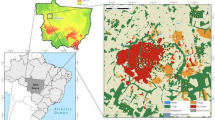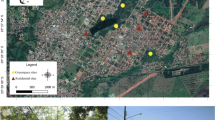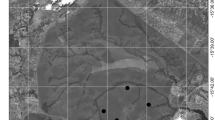Abstract
Urbanization is increasing globally and causing rapid taxonomic and functional changes in biological communities. Its effects through time in the same communities have not been addressed properly. Here, we evaluate the temporal changes in taxonomic and functional diversity of dung beetles between greenspace (Cerrado stricto sensu) and residential sites in an urban landscape in the Brazilian Cerrado. We sampled dung beetles across 3 years (2013–2015) during the rainy season in the same sites. We evaluated these temporal changes using Temporal Beta Index and beta diversity partitioning into its components of replacement and gain/loss. We expected that residential sites will be taxonomically and functionally poorer compared to greenspace sites over the years. We found a general loss of species and abundance-per species from 2013 to 2015, which was more pronounced in residential sites than greenspace sites, since greenspace sites showed some gain of species from 2014 to 2015. Functional richness, functional evenness, and functional divergence did not change over the years, but were always lower in residential sites than greenspace sites. Functional β-diversity did not change over the years, but was always higher in residential sites than greenspace sites, with similar contribution of functional replacement and nestedness-resultant components. We demonstrate that greenspace sites are taxonomically and functionally more stable, temporally, than residential sites.
Implications for insect conservation
We advocate that public policies aimed at conservation and management of greenspace sites are important tools for maintaining dung beetle diversity and their ecosystem functions in urbanized landscapes in the Brazilian Cerrado.




Similar content being viewed by others
References
Alvares CA, Stape JL, Sentelhas PC et al (2013) Köppen’s climate classification map for Brazil. Meteorol Z 22:711–728. https://doi.org/10.1127/0941-2948/2013/0507
Anderson MJ, Crist TO, Chase JM et al (2011) Navigating the multiple meanings of beta diversity: a roadmap for the practicing ecologist. Ecol Lett 14:19–28. https://doi.org/10.1111/j.1461-0248.2010.01552.x
Audino LD, Murphy SJ, Zambaldi L et al (2017) Drivers of community assembly in tropical forest restoration sites: role of local environment, landscape, and space. Ecol Appl 27:1731–1745. https://doi.org/10.1002/eap.1562
Barragan F, Moreno CE, Escobar F et al (2011) Negative impacts of human land use on dung beetle functional diversity. PLoS ONE 6:e17976. https://doi.org/10.1371/journal.pone.0017976
Barros WM, Gomes RL, Marcato Júnior J (2015) Análise dos contingentes populacional e habitacional da cidade de Aquidauana-MS: atualização e perspectiva. Revista GeoPantanal 19:59–69
Baselga A (2010) Partitioning the turnover and nestedness components of beta diversity. Glob Ecol Biogeogr 19:134–143. https://doi.org/10.1111/j.1466-8238.2009.00490.x
Baselga A (2012) The relationship between species replacement, dissimilarity derived from nestedness, and nestedness. Glob Ecol Biogeogr 21:1223–1232. https://doi.org/10.1111/j.1466-8238.2011.00756.x
Baselga A, Orme CDL (2012) betapart: an R package for the study of beta diversity. Methods Ecol Evol 3:808–812. https://doi.org/10.1111/j.2041-210X.2012.00224.x
Bolund P, Hunhammar S (1999) Ecosystem services in urban areas. Ecol Econ 29:293–301. https://doi.org/10.1016/S0921-8009(99)00013-0
Braga RF, Korasaki V, Andresen E et al (2013) Dung beetle community and functions along a habitat-disturbance gradient in the Amazon: a rapid assessment of ecological functions associated to biodiversity. PLoS ONE 8:e57786. https://doi.org/10.1371/journal.pone.0057786.g001
Brannstrom C, Jepson W, Filippi AM et al (2008) Land change in the Brazilian Savanna (Cerrado), 1986–2002: comparative analysis and implications for land-use policy. Land Use Policy 25:579–595. https://doi.org/10.1016/j.landusepol.2007.11.008
Carvalho JMA (2004) Crescimento populacional e estrutura demográfica do Brasil. UFMG/Cedeplar, Belo Horizonte
Carvalho FMV, De Marco P, Ferreira LG (2009) The Cerrado into-pieces: habitat fragmentation as a function of landscape use in the savannas of central Brazil. Biol Conserv 142:1392–1403. https://doi.org/10.1016/j.biocon.2009.01.031
Cheptou P-O, Hargreaves AL, Bonte D et al (2017) Adaptation to fragmentation: evolutionary dynamics driven by human influences. Philos Trans R Soc B 372:20160037. https://doi.org/10.1098/rstb.2016.0037
Collevatti RG, Terribile LC, de Oliveira G et al (2013) Drawbacks to palaeodistribution modelling: the case of South American seasonally dry forests. J Biogeogr 40:345–358. https://doi.org/10.1111/jbi.12005
Correa CMA, Puker A, Korasaki V et al (2016) Attractiveness of baits to dung beetles in Brazilian savanna and exotic pasturelands. Entomol Sci 19:112–123. https://doi.org/10.1111/ens.12169
Correa CMA, Braga RF, Puker A et al (2019) Patterns of taxonomic and functional diversity of dung beetles in a human-modified variegated landscape in Brazilian Cerrado. J Insect Conserv 23:89–99. https://doi.org/10.1007/s10841-018-00118-6
Correa CMA, Ferreira KR, Puker A et al (2021) Greenspace sites conserve taxonomic and functional diversity of dung beetles in an urbanized landscape in the Brazilian Cerrado. Urban Ecosyst. https://doi.org/10.1007/s11252-021-01093-8
Crawley MJ (2013) The R Book. Wiley, Chichester
da Silva PG, Hernández MIM (2015) Spatial patterns of movement of dung beetle species in a tropical forest suggest a new trap spacing for dung beetle biodiversity studies. PLoS ONE 10:e0126112. https://doi.org/10.1371/journal.pone.0126112
da Silva PG, Hernández MIM, Heino J (2018) Disentangling the correlates of species and site contributions to beta diversity in dung beetle assemblages. Divers Distrib 24:1674–1686. https://doi.org/10.1111/ddi.12785
da Silva PG, Nunes CA, Ferreira LF et al (2019) Patch and landscape effects on forest-dependent dung beetles are masked by matrix-tolerant dung beetles in a mountaintop rainforest archipelago. Sci Total Environ 651:1321–1331. https://doi.org/10.1016/j.scitotenv.2018.09.195
Dray S, Bauman D, Blanchet G et al (2020) adespatial: multivariate multiscale spatial analysis. R package version 0.3-7. https://CRAN.R-project.org/package=adespatial
Edmonds WD, Zídek J (2010) A taxonomic review of the Neotropical genus Coprophanaeus Olsoufieff, 1924 (Coleoptera, Scarabaeidae, Scrabaeinae). Insecta Mundi 274:1–108
Filgueiras BKC, Melo DHA, Andersen AN et al (2019) Cross-taxon congruence in insect responses to fragmentation of Brazilian Atlantic forest. Ecol Indic 98:523–530. https://doi.org/10.1016/j.ecolind.2018.11.036
Fina BG, Monteiro R (2013) Análise da estrutura arbustivo-arbórea de uma área de Cerrado sensu stricto, município de Aquidauana-Mato Grosso do Sul. Rev Arvore 37:577–585. https://doi.org/10.1590/S0100-67622013000400001
Frizzas MR, Batista JB, Rocha MJ et al (2020) Diversity of Scarabaeinae (Coleoptera: Scarabaeidae) in an urban fragment of Cerrado in Central Brazil. Eur J Endocrinol 117:273–281. https://doi.org/10.14411/eje.2020.031
Gardner TA, Barlow J, Araujo IS et al (2008) The cost-effectiveness of biodiversity surveys in tropical forests. Ecol Lett 11:139–150. https://doi.org/10.1111/j.1461-0248.2007.01133.x
Halffter G (1991) Historical and ecological factors determining the geographical distribution of beetles (Coleoptera: Scarabaeidae: Scarabaeinae). Folia Entomol Mex 82:195–238. https://doi.org/10.21426/B615110376
Halffter G, Arellano L (2002) Response of dung beetle diversity to human-induced changes in a tropical landscape. Biotropica 34:144–154. https://doi.org/10.1111/j.1744-7429.2002.tb00250.x
Halffter G, Edmonds WD (1982) Nesting behavior of dung beetles (Scarabaeinae). Man and Biosphere Program—UNESCO, Mexico, D.F.
Halffter G, Favila ME (1993) The Scarabaeinae (Insecta: Coleoptera) an animal group for analysing, inventorying and monitoring biodiversity in Tropical Rainforest and modified landscapes. Biol Int 27:15–21
Halffter G, Matthews EG (1966) The natural history of dung beetles of the subfamily Scarabaeinae (Coleoptera, Scarabaeidae). Folia Entomol Mex 12–14:1–312. https://doi.org/10.1002/mmnz.19690450211
Hanski I, Cambefort Y (1991) Dung beetle ecology. Princeton University Press, Princeton
IBGE (2019) Cidades. Instituto Brasileiro de Geografia e Estatística, Rio de Janeiro, Brazil. http://www.ibge.gov.br. Accessed 8 Sept 2020
Jiménez-Ferbans L, Mendieta-Otálora W, García H et al (2008) Notas sobre los escarabajos coprófagos (Coleoptera: Scarabaeinae) en ambientes secos de la región de Santa Marta, Colombia. Acta Biol Colomb 13:203–303
Klink C, Machado RB (2005) A conservação do Cerrado brasileiro. Megadiversidade 1:147–155
Korasaki V, Lopes J, Brown GG et al (2013) Using dung beetles to evaluate the effects of urbanization on Atlantic Forest biodiversity. Insect Sci 20:393–406. https://doi.org/10.1111/j.1744-7917.2012.01509.x
Laliberté E, Legendre P, Shipley B (2014) FD: measuring functional diversity from multiple traits, and other tools for functional ecology. R package version 1.0-12
Legendre P (2014) Interpreting the replacement and richness difference components of beta diversity. Glob Ecol Biogeogr 23:1324–1334. https://doi.org/10.1111/geb.12207
Legendre P (2019) A temporal beta-diversity index to identify sites that have changed in exceptional ways in space–time surveys. Ecol Evol 9:3500–3514. https://doi.org/10.1002/ece3.4984
Legendre P, Condit R (2019) Spatial and temporal analysis of beta diversity in the Barro Colorado Island forest dynamics plot, Panama. For Ecosyst 6:7. https://doi.org/10.1186/s40663-019-0164-4
Legendre P, Gallagher E (2001) Ecologically meaningful transformations for ordination of species data. Oecologia 129:271–280. https://doi.org/10.1007/s004420100716
Legendre P, De Cáceres M, Borcard D (2010) Community surveys through space and time: testing the space-time interaction in the absence of replication. Ecology 91:262–272
Lobo JM (1993) Estimation of dung beetle biomass (Coleoptera: Scarabaeoidea). Eur J Entomol 90:235–238
MacGregor-Fors I, Escobar F, Rueda-Hernández R et al (2016) City “green” contributions: the role of urban greenspaces as reservoirs for biodiversity. Forests 7:146. https://doi.org/10.3390/f7070146
Magurran AE, Dornelas M, Moyes F et al (2019) Temporal β diversity—a macroecological perspective. Glob Ecol Biogeogr 28:1949–1960. https://doi.org/10.1111/geb.13026
Maire E, Grenouillet G, Brosse S et al (2015) How many dimensions are needed to accurately assess functional diversity? A pragmatic approach for assessing the quality of functional spaces. Glob Ecol Biogeogr 24:728–740. https://doi.org/10.1111/geb.12299
Maldaner ME, Vaz-de-Mello FZ, Takya DM, Ferreira DC (2020) Molecular phylogeny of coprophanaeus (Megaphanaeus) d'Olsoufieff, 1924 (Coleoptera: Scarabaeidae: Scarabaeinae) and the position of C. bellicosus. Insect Syst Evol 51:241–255. https://doi.org/10.1163/1876312X-00002198
Martinson HM, Raupp MJ (2013) A meta-analysis of the effects of urbanization on ground beetle communities. Ecosphere 4:art60. https://doi.org/10.1890/ES12-00262.1
McDonald RI, Kareiva P, Forman RTT (2008) The implications of current and future urbanization for global protected areas and biodiversity conservation. Biol Conserv 141:1695–1703. https://doi.org/10.1016/j.biocon.2008.04.025
Merckx T, Souffreau C, Kaiser A et al (2018) Body-size shifts in aquatic and terrestrial urban communities. Nature 558:113–116. https://doi.org/10.1038/s41586-018-0140-0
Myers N, Mittermeier RA, Mittermeier CG et al (2000) Biodiversity hotspots for conservation priorities. Nature 403:853–845. https://doi.org/10.1038/35002501
Nagy DD, Magura T, Horváth R et al (2018) Arthropod assemblages and functional responses along an urbanization gradient: a trait-based multi-taxa approach. Urban For Urban Green 30:157–168. https://doi.org/10.1016/j.ufug.2018.01.002
Nichols E, Spector S, Louzada J et al (2008) Ecological functions and ecosystem services provided by Scarabaeinae dung beetles. Biol Conserv 141:1461–1474. https://doi.org/10.1016/j.biocon.2008.04.011
Podani J (1999) Extending Gower’s general coefficient of similarity to ordinal characters. Taxon 48:331–340. https://doi.org/10.2307/1224438
Puker A, Correa CMA, Korasaki V (2014) Deltochilini and Phanaeini dung beetles (Coleoptera: Scarabaeidae: Scarabaeinae) in introduced and native ecosystems of Brazil. J Nat Hist 48:2105–2116. https://doi.org/10.1080/00222933.2014.908969
R Core Team (2020) R: a language and environment for statistical computing. R Foundation for Statistical Computing, Austria, Vienna
Radtke MG, Carlton CE, Williamson GB (2008) A dung beetle assemblage in an urban park in Louisiana. Southeast Nat 7:101–110. https://doi.org/10.1656/1528-7092(2008)7[101:ADBAIA]2.0.CO;2
Ramírez-Restrepo L, Halffter G (2016) Copro-necrophagous beetles (Coleoptera: Scarabaeinae) in urban areas: a global review. Urban Ecosyst 19:1179–1195. https://doi.org/10.1007/s11252-016-0536-2
Salomão RP, Alvarado F, Baena-Díaz F et al (2019) Urbanization effects on dung beetle assemblages in a tropical city. Ecol Indic 103:665–675. https://doi.org/10.1016/j.ecolind.2019.04.045
Salomão RP, Favila ME, González-Tokman D (2020) Spatial and temporal changes in the dung beetle diversity of a protected, but fragmented, landscape of the northernmost Neotropical rainforest. Ecol Indic 111:105968. https://doi.org/10.1016/j.ecolind.2019.105968
Sano EE, Rosa R, Brito JLS et al (2010) Land cover mapping of the tropical savanna region in Brazil. Environ Monit Assess 166:113–124. https://doi.org/10.1007/s10661-009-0988-4
Seto KC, Güneralp B, Hutyra LR (2012) Global forecasts of urban expansion to 2030 and direct impacts on biodiversity and carbon pools. Proc Natl Acad Sci USA 109:16083–16088. https://doi.org/10.1073/pnas.1211658109
Slade EM, Mann DJ, Villanueva JF et al (2007) Experimental evidence for the effects of dung beetle functional group richness and composition on ecosystem function in a tropical forest. J Anim Ecol 76:1094–1104. https://doi.org/10.1111/j.1365-2656.2007.01296.x
Souza EP, Martins SRO (2010) Conflitos territoriais em torno do Parque da Lagoa Comprida, Aquidauana (MS). Percurso 1:273–289
Spector S (2006) Scarabaeine dung beetles (Coleoptera: Scarabaeidae: Scarabaeinae): an invertebrate focal taxon for biodiversity research and conservation. Coleopts Bull Monograph Number 5:71–83. https://doi.org/10.1649/0010-065X(2006)60[71:SDBCSS]2.0.CO;2
Taylor L, Hochuli DF (2017) Defining greenspace: multiple uses across multiple disciplines. Landsc Urban Plan 158:25–38. https://doi.org/10.1016/j.landurbplan.2016.09.024
Teodoro PE, Correa CCG, Torres EF et al (2015) Analysis of the occurrence of wet and drought periods using standardized precipitation index in Mato Grosso do Sul state, Brazil. J Agron 14:80–86. https://doi.org/10.3923/ja.2015.80.86
Tissiani ASO, Vaz-de-Mello FZ, Campelo-Júnior JH (2017) Dung beetles of Brazilian pastures and key to genera identification (Coleoptera: Scarabaeidae). Pesqui Agropecu Bras 52:401–418. https://doi.org/10.1590/s0100-204x2017000600004
Vaz-de-Mello FZ, Edmonds WD, Ocampo FC et al (2011) A multilingual key to the genera and subgenera of the subfamily Scarabaeinae of the New World (Coleoptera: Scarabaeidae). Zootaxa 2854:1–73. https://doi.org/10.11646/zootaxa.2854.1.1
Villéger S, Mason NWH, Mouillot D (2008) New multidimensional functional diversity indices for a multifaceted framework in functional ecology. Ecology 89:2290–2301. https://doi.org/10.1890/07-1206.1
Villéger S, Novack-Gottshall PM, Mouillot D (2011) The multidimensionality of the niche reveals functional diversity changes in benthic marine biotas across geological time. Ecol Lett 14:561–568. https://doi.org/10.1111/j.1461-0248.2011.01618.x
Villéger S, Miranda JR, Hernandez DF et al (2012) Low functional β-diversity despite high taxonomic β-diversity among tropical estuarine fish communities. PLoS ONE 7:e40679. https://doi.org/10.1371/journal.pone.0040679
Villéger S, Grenouillet G, Brosse S (2013) Decomposing functional β-diversity reveals that low functional β-diversity is driven by low functional turnover in European fish assemblages. Glob Ecol Biogeogr 22:671–681. https://doi.org/10.1111/geb.12021
Woodward G, Ebenman B, Emmerson M et al (2005) Body size in ecological networks. Trends Ecol Evol 20:402–409. https://doi.org/10.1016/j.tree.2005.04.005
Acknowledgements
We thank Fernando Z. Vaz-de-Mello (UFMT) for dung beetle identification; Alfredo Raúl Abot (Universidade Estadual de Mato Grosso do Sul, Aquidauana, Mato Grosso do Sul, Brazil) for his lab equipment for insect screening, Mateus Alves and Paulo André Silva for the field support. The samplings were issued by the Instituto Chico Mendes de Conservação da Biodiversidade (ICMBio), the Brazilian biodiversity regulation governmental institute. CMAC thanks Coordenação de Aperfeiçoamento de Pessoal de Nível Superior ‘Bolsista CAPES/Brasil’ for postdoctoral grant (88887.603414/2021-00). PGdS thanks CAPES for postdoctoral grant (PNPD 88882.316025/2019-01, Code 001).
Author information
Authors and Affiliations
Corresponding author
Ethics declarations
Conflict of interest
The authors declare that they have no conflicts of interests.
Additional information
Publisher's Note
Springer Nature remains neutral with regard to jurisdictional claims in published maps and institutional affiliations.
Supplementary Information
Below is the link to the electronic supplementary material.
Rights and permissions
About this article
Cite this article
Correa, C.M.A., da Silva, P.G., Ferreira, K.R. et al. Residential sites increase species loss and cause high temporal changes in functional diversity of dung beetles in an urbanized Brazilian Cerrado landscape. J Insect Conserv 25, 417–428 (2021). https://doi.org/10.1007/s10841-021-00310-1
Received:
Accepted:
Published:
Issue Date:
DOI: https://doi.org/10.1007/s10841-021-00310-1




